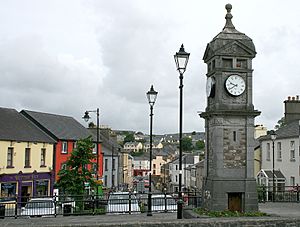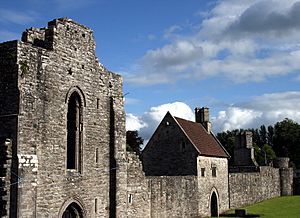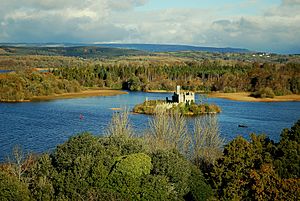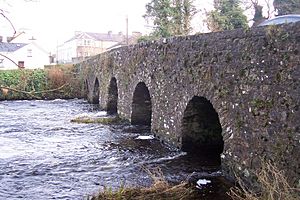Boyle, County Roscommon facts for kids
Quick facts for kids
Boyle
Mainistir na Búille
|
|
|---|---|
|
Town
|
|

Market Square
|
|
| Country | Ireland |
| Province | Connacht |
| County | County Roscommon |
| Elevation | 83 m (272 ft) |
| Population
(2022)
|
2,915 |
| Time zone | UTC±0 (WET) |
| • Summer (DST) | UTC+1 (IST) |
| Eircode routing key |
F52
|
| Telephone area code | +353(0)71 |
| Irish Grid Reference | G797019 |
| Historical population | ||
|---|---|---|
| Year | Pop. | ±% |
| 1813 | 2,272 | — |
| 1821 | 3,407 | +50.0% |
| 1831 | 3,433 | +0.8% |
| 1841 | 3,235 | −5.8% |
| 1851 | 2,727 | −15.7% |
| 1861 | 3,098 | +13.6% |
| 1871 | 3,347 | +8.0% |
| 1881 | 2,994 | −10.5% |
| 1891 | 2,464 | −17.7% |
| 1901 | 2,477 | +0.5% |
| 1911 | 2,691 | +8.6% |
| 1926 | 2,323 | −13.7% |
| 1936 | 1,727 | −25.7% |
| 1946 | 2,071 | +19.9% |
| 1951 | 1,934 | −6.6% |
| 1956 | 1,835 | −5.1% |
| 1961 | 1,739 | −5.2% |
| 1966 | 1,789 | +2.9% |
| 1971 | 1,939 | +8.4% |
| 1981 | 2,252 | +16.1% |
| 1986 | 2,383 | +5.8% |
| 1991 | 2,197 | −7.8% |
| 1996 | 2,222 | +1.1% |
| 2002 | 2,205 | −0.8% |
| 2006 | 2,522 | +14.4% |
| 2011 | 2,588 | +2.6% |
| 2016 | 2,568 | −0.8% |
| 2022 | 2,915 | +13.5% |
Boyle (pronounced 'boyl') is a town in County Roscommon, Ireland. It is located at the base of the Curlew Mountains, close to Lough Key in the northern part of the county. Nearby attractions include the Carrowkeel Megalithic Cemetery, the Drumanone Dolmen, and the lakes of Lough Arrow and Lough Gara. In 2022, the town had a population of 2,915 people. Boyle is part of a civil parish and a barony, both named Boyle.
Contents
History of Boyle
Early Times
A significant battle called the Battle of Curlew Pass took place near Boyle on August 15, 1599. This battle was part of the Nine Years' War in Ireland. English forces, led by Sir Conyers Clifford, were ambushed by an Irish army led by Aodh Ruadh Ó Domhnaill (Red Hugh O'Donnell) in the Curlew Mountains. The English suffered heavy losses in this surprise attack. This defeat was considered one of the biggest setbacks for the English in Ireland at the time.
Boyle also faced great difficulties during the Great Famine from 1847 to 1849. Many people suffered from hunger and illness during this period. Local stories tell of the immense hardship, with people struggling to survive and help their communities.
Boyle in the 1800s
By 1859, Boyle was described as a busy town with important buildings. These included a courthouse, hospitals, schools, and offices for local estates. It also had police barracks, a church, and a public garden. People noted the well-preserved ruins of Boyle Abbey, which was considered a very interesting old building. Boyle was a main town in County Roscommon, serving the surrounding area with many shops.
By 1881, the town had grown even more. It had a medical dispensary, three banks, three hotels, and two newspapers. Boyle also had a post office, 40 grocery shops, and 25 pubs. Many other businesses, like bakeries, butchers, and hardware stores, served the community. There were churches for both Protestant and Catholic residents.
Boyle in the 1900s
In 1917, Boyle became famous for a political event. Sinn Féin, an Irish political party, won its first seat in the parliament for the North Roscommon area, which included Boyle. George Noble Plunkett was elected. His son, Joseph Mary Plunkett, had been executed by the British in 1916 after the 1916 Rising. Important figures like Michael Collins helped campaign for Plunkett. A plaque on the courthouse in Boyle remembers this historic election. It was a very important moment for Sinn Féin after the Easter Rising.
Famous Landmarks
King House
King House is a beautiful old mansion in the center of Boyle. It was built between 1720 and 1740 for the King family, who were very wealthy. The house was carefully restored in 1989 after being neglected for many years. It was even almost torn down to make way for a car park!
The house has a large U-shape and might include parts of an older house that burned down. It's unusual for such a grand house to be right in the middle of a town. Most big houses were built on large estates outside towns.
After 1810, the King family moved out, and King House became a military barracks. It was home to the Connaught Rangers soldiers for many years. When Ireland became independent in 1922, the new Irish National Army took over the house. They renamed it Dockery Barracks.
In 1987, Roscommon County Council bought the building. They started a big restoration project in 1989. Skilled local craftspeople used traditional methods to fix the house. All three floors and the basement were restored. Visitors can now see the main entrance, vaulted ceilings, and the main salon. Other rooms host temporary exhibitions. The "Kings of Connaught" exhibition tells the story of the region's ancient kings and the King family who lived in the house. It also shows how the house was restored.
Boyle Abbey
Boyle Abbey is a Cistercian monastery founded in the 12th century. It was supported by the local ruling family, the MacDermotts. The abbey is one of the best-preserved old monasteries in Ireland. Building began around 1161. The church has a mix of rounded and pointed arches. The large square tower was part of the church from the beginning, though it was made taller later.
The eastern part of the church has well-preserved stone carvings on its pillars. Different parts of the church were built at different times, showing changes in building styles. The church was officially finished in 1218.
Sadly, the cloister (the covered walkway around a courtyard) is gone. However, there is a two-story gatehouse on the west side. This gatehouse now serves as a visitor center. The other buildings around the cloister were mostly built in the 16th or 17th centuries.
Boyle Abbey was very important in the Connacht region. It was damaged in the 17th and 18th centuries when it was used by soldiers. Despite this, it remains one of the best examples of its kind. Thousands of visitors come to see it every year. The Abbey is now a national monument cared for by the state. Look closely above one of the central arches, and you might spot a hidden carving called a Sheela na gig!
Lough Key Forest Park
Lough Key Forest Park is a large parkland area located off the N4 road. It has a visitor center and many fun activities. One popular activity is Boda Borg, a unique puzzle-solving center that came from Sweden. The park covers about 800 acres (3.2 square kilometers).
This land was once part of the Rockingham estate, owned by the Stafford-King-Harman family. Their grand home, Rockingham House, was designed by John Nash in the early 1800s. It was a huge house with a domed front and 365 windows.
Sadly, Rockingham House was destroyed by a fire in 1957. It was later torn down in 1970 because it was unsafe. You can still find tunnels that once led to the house. A viewing tower was built in 1973, offering great views. In the town park behind King House, there used to be a statue of William of Orange. Locals pulled it down in 1945, but its base is still there.
Lough Key has several islands. Castle Island is well-known. Trinity Island has the ruins of a chapel, which was connected to Boyle Abbey. Two trees on Trinity Island have branches that are linked together. People say they mark the graves of Una Bhan Mac Diarmid and Tomás Láidir Mac Coisdealbhaigh, two lovers from a famous Irish poem.
Other Interesting Places
The Abbeytown bridge is a stone bridge with five arches that crosses the Boyle River near the abbey. It was first built in the late 12th century, making it one of Ireland's oldest surviving stone bridges. Even though it has been made wider, it can still carry a 5-ton load.
The Drumanone dolmen is an ancient portal tomb located just west of Boyle. It is a very important archaeological site in Ireland and Europe. This dolmen was built before 2000 BC. Its capstone, which is the large flat stone on top, measures about 4.5 meters by 3 meters and is one of the biggest in Ireland. The Drumanone Dolmen has tall portal stones, over 2 meters high, and a doorstone about 2 meters high. The capstone is about 4 meters square. It sits in a field about 300 meters north of the Boyle River.
The 'Gaelic Chieftain' is a large sculpture found overlooking the Curlew Pass, just outside Boyle. This impressive artwork remembers the Battle of Curlew Pass.
Getting Around Boyle
Boyle railway station opened on December 3, 1862. Boyle is on the railway line that connects Dublin to Sligo. The main N4 road from Dublin to Sligo also passes near the town. Boyle is connected to the River Shannon by the Boyle canal, the Boyle River, and Lough Key.
The town used to be directly on the N4 national primary road, but a bypass was built in 1999. Now, the R294 regional road connects Boyle to the N4. The R294 also links Boyle to Ballina, County Mayo. The N61 national secondary road connects Boyle to Athlone via Roscommon.
Boyle also has a LocalLink bus service that travels to Roscommon three times a day.
Famous People from Boyle
- Michael Bowles (1909–1998), an orchestral conductor, grew up in Boyle.
- John Carty, a traditional Irish musician, has lived in Boyle since 2003.
- Margaret Cousins (1878–1954), was a suffragette and a campaigner for women's rights.
- John McGahern, a famous writer, grew up near Boyle. The town is mentioned in many of his books.
- Chris O'Dowd, a well-known actor and comedian, was born in Boyle. He filmed parts of his comedy show Moone Boy in the town in 2012 and 2013.
- Maureen O'Sullivan (1911–1998), an actress, was born in Boyle.
- John Reilly (1926–1969), a singer, lived in Boyle. He is known for sharing many traditional folk songs.
Boyle Arts Festival
The Boyle Arts Festival is a popular summer event that has been held since 1990. The festival showcases art by modern Irish artists. It also features classical and traditional music, poetry, drama, talks, and special events for children.
See also
 In Spanish: Boyle (Irlanda) para niños
In Spanish: Boyle (Irlanda) para niños








